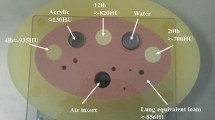Abstract
Recently, region-setting computed tomography (CT) has been studied as a region of interest imaging method. This technique can strongly reduce the radiation dose by limiting the irradiation field. Although mathematical studies have been performed for reduction of the truncation artifact, no experimental studies have been performed so far. In this study, we developed a three-dimensional region-setting CT system and evaluated its imaging properties. As an experimental system, we developed an X-ray CT system with multileaf collimators. In this system, truncated projection data can be captured by limiting of the radiation field. In addition, a truncated projection data correction was performed. Finally, image reconstruction was performed by use of the Feldkamp–Davis–Kress algorithm. In the experiments, the line profiles and the image quality of the reconstructed images were evaluated. The results suggested that the image quality of the proposed method is comparable to that of the original method. Furthermore, we confirmed that the radiation dose was reduced when this system was used. These results indicate that a 3D region-setting CT system using 6-channel multileaf collimators can reduce the radiation dose without in causing a degradation of image quality.













Similar content being viewed by others
References
UNSCEAR 2008 report. Vol. I: sources of ionizing radiation. Annex A: medical radiation exposures. 2010. http://www.unscear.org/docs/reports/2008/09-86753_Report_2008_Annex_A.pdf. Accessed 14 Mar 2016.
Asada Y, Suzuki S, Kobayashi K, Kato H. Investigation of patient exposure doses in diagnostic radiography in 2011 questionnaire. Nihon Hoshasen Gijutsu Gakkai Zasshi. 2013;69:371–9.
de González A, Darby S. Risk of cancer from diagnostic X-rays: estimates for the UK and 14 other countries. Lancet. 2004;363:345–51.
Brenner D, Hall E. Computed tomography—an increasing source of radiation exposure. N Engl J Med. 2007;357:2277–84.
Nguyen P, Lee W, Li Y, Hong W. Assessment of the radiation effects of cardiac CT angiography using protein and genetic biomarkers. JACC Cardiovasc Imaging. 2015;8:873–84.
Silva A, Lawder H, Hara A. Innovations in CT dose reduction strategy: application of the adaptive statistical iterative reconstruction algorithm. AJR Am J Roentgenol. 2010;194:191–9.
Xia Y, Dennerlein F, Bauer S. Scaling calibration in region of interest reconstruction with the 1D and 2D ATRACT algorithm. Int J Comput Assist Radiol Surg. 2014;9:345–56.
Seger MM. Rampfilter implementation on truncated projection data. Application to 3D linear tomography for logs. In: proc. SSAB02 symp. image anal. 2002. p. 33–36.
Ohnesorge B, Flohr T, Schwarz K, Heiken J, Bae K. Efficient correction for CT image artifacts caused by objects extending outside the scan field of view. Med Phys. 2000;27:39–46.
Noo F, Clackdoyle R, Pack J. A two-step Hilbert transform method for 2D image reconstruction. Phys Med Biol. 2004;49:3903–23.
Kudo H, Courdurier M, Noo F, Defrise M. Tiny a priori knowledge solves the interior problem in computed tomography. Phys Med Biol. 2008;53:2207–31.
Gong H, Lu J, Zhou O, Cao G. Implementation of interior micro-CT on a carbon nanotube dynamic micro-CT scanner for lower radiation dose. In: proc SPIE med. imaging. int. soc. opt. photonics. 2015. p. 94124N–94124N–9.
Natterer F. The mathematics of computerized tomography. New York: Siam; 1986. p. 158–79.
Hashimoto F, Teramoto A, Asada Y, Suzuki S, Fujita H. Development of the two-dimensional region-setting CT system: development and basic evaluation of the experimental system using the active collimators. Med Imaging Technol. 2016;34:123–7.
Shepp L, Kruskal J. Computerized tomography: the new medical X-ray technology. Am Math Mon. 1978;85:420–39.
Feldkamp L, Davis L, Kress J. Practical cone-beam algorithm. J Opt Soc Am A. 1984;1:612–9.
Penney BC. Constrained least-squares restoration of nuclear medicine images: selecting the coarseness function. Med Phys. 1987;14:849–58.
Acknowledgments
I would like to show my greatest appreciation to Chika Murata, whose comments and suggestions were of inestimable value for my study. This manuscript was presented orally at the 71st Annual meeting of the Japanese Society of Radiological Technology.
Author information
Authors and Affiliations
Corresponding author
Ethics declarations
Conflict of interest
The authors declare that they have no conflict of interest.
About this article
Cite this article
Hashimoto, F., Teramoto, A., Asada, Y. et al. Dose reduction technique in diagnostic X-ray computed tomography by use of 6-channel multileaf collimators. Radiol Phys Technol 10, 60–67 (2017). https://doi.org/10.1007/s12194-016-0368-z
Received:
Revised:
Accepted:
Published:
Issue Date:
DOI: https://doi.org/10.1007/s12194-016-0368-z




